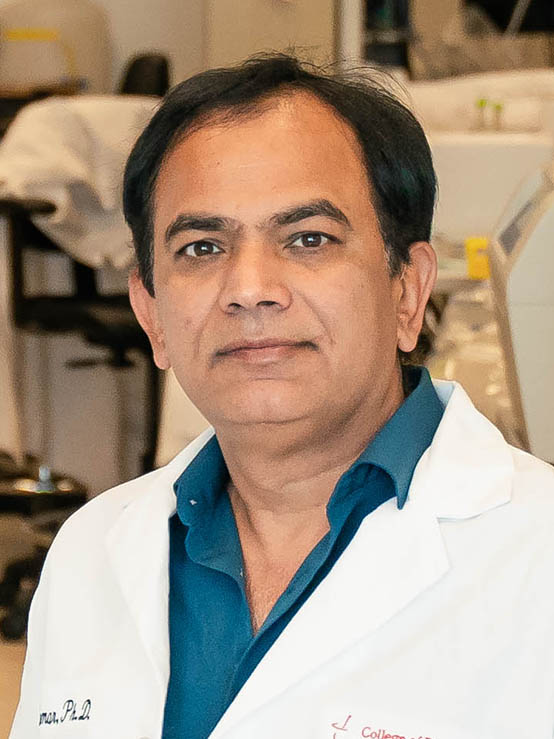Faculty Profile
 Ashok Kumar
Ashok Kumar
Professor of Pharmacology
Else and Philip Hargrove Endowed Professor of Drug Discovery
Department of Pharmacological and Pharmaceutical Sciences
Director, Institute of Muscle Biology and Cachexia
Office:
University of Houston College of Pharmacy
Health 2, Room 5012
4349 Martin Luther King Boulevard
Houston, TX 77204-5037
Contact: akumar43@central.uh.edu - 713-743-3376
Research:
Research in our laboratory is focused towards understanding molecular and signaling mechanisms that regulate skeletal muscle mass and function in various conditions such as cancer cachexia, denervation, and sepsis. We are also studying mechanisms of skeletal muscle growth and metabolic adaptation in response to exercise and other anabolic stimuli. In addition, we investigate novel signaling mechanisms that regulate self-renewal and differentiation of satellite stem cells and regeneration of skeletal muscle in adults. Finally, we are also investigating pathophysiological mechanisms in muscular dystrophy to identify new drug targets. Our research work employ several genetics, molecular, cell biological, and physiological approaches.
NCBI Bibliography
ORCID Profile
- Ph.D. in Tumor Biology, University of Delhi, Delhi, India
- M.S. in Computer Science, University of Houston Clear Lake, Houston, Texas
- M.Tech. in Biochemical Engineering and Biotechnology, Indian Institute of Technology Delhi, Delhi, India
- M.Sc. in Biotechnology, Banaras Hindu University, Varanasi, India
- B.Sc. in Chemistry (Hons.), Rajdhani College, University of Delhi, Delhi, India
- Post-doctorate in Biochemistry and Molecular Biology at The University of Texas MD Anderson Cancer Center and Baylor College of Medicine, Houston, Texas
Google Scholar Profile
- Tomaz da Silva M, Roy A, Vuong AT, Joshi AS, Josphien C, Trivedi MV, Hindi SM, Narkar VA, Kumar A (2025). The TWEAK/Fn14 signaling mediates skeletal muscle wasting during cancer cachexia. iScience. 28:112714. doi: 10.1016/j.isci.2025.112714. PMID: 40585358.
- Tomaz da Silva M, Joshi AS, Kumar A (2025). Fibroblast growth factor-inducible 14 regulates satellite cell self-renewal and expansion during skeletal muscle repair. JCI Insight. 10:e187825. doi: 10.1172/jci.insight.187825. PMID: 39874107.
- Joshi AS, Castillo MB, Tomaz da Silva M, Vuong AT, Gunaratne PH, Darabi R, Liu Y, Kumar A (2024). Single-nucleus transcriptomic analysis reveals the regulatory circuitry of myofiber XBP1 during regenerative myogenesis. iScience. 27:111372. doi: 10.1016/j.isci.2024.111372. PMID: 39650729.
- Joshi AS, Tomaz da Silva M, Roy A, Koike TE, Wu M, Castillo MB, Gunaratne PH, Liu Y, Iwawaki T, Kumar A (2024). The IRE1α/XBP1 signaling axis drives myoblast fusion in adult skeletal muscle. EMBO Reports. 25:3627-3650. doi: 10.1038/s44319-024-00197-4. PMID: 38982191.
- Roy A, Joshi AS, Kumar A (2024). ER stress and ERO1: Potential therapeutic targets for inherited myopathies. Cell Reports Medicine. 5:101462. doi: 10.1016/j.xcrm.2024.101462. PMID: 38508147.
- Kumar A, Narkar VA (2023). Nuclear receptors as potential therapeutic targets in peripheral arterial disease and related myopathy. FEBS Journal. 290:4596-4613. doi: 10.1111/febs.16593. PMID: 35942640.
- Roy A, Koike TE, Joshi AS, Tomaz da Silva M, Mathukumalli K, Wu M, Kumar A (2023). Targeted regulation of TAK1 counteracts dystrophinopathy in a DMD mouse model. JCI Insight. 8:e164768. doi: 10.1172/jci.insight.164768. PMID: 37071470.
- Roy A, Kumar A (2022). Supraphysiological activation of TAK1 promotes skeletal muscle growth and mitigates neurogenic atrophy. Nature Communications. 13:2201. doi: 10.1038/s41467-022-29752-0. PMID: 35459245.
- Roy A, Tomaz da Silva M, Bhat R, Bohnert KR, Iwawaki T, Kumar A (2021). The IRE1/XBP1 signaling axis promotes skeletal muscle regeneration through a cell non-autonomous mechanism. Elife. 10:e73215. doi: 10.7554/eLife.73215. PMID: 34812145.
- Bohnert KR, Goli P, Roy A, Sharma AK, Xiong G, Gallot YS, Kumar A (2019). The Toll-Like Receptor/MyD88/XBP1 Signaling Axis Mediates Skeletal Muscle Wasting during Cancer Cachexia. Molecular and Cellular Biology. 39: e00184-19. doi: 10.1128/MCB.00184-19. PMID: 31138662.
- Hindi SM, Sato S, Xiong G, Bohnert KR, Gibb AA, Gallot YS, McMillan JD, Hill BG, Uchida S, Kumar A (2018). TAK1 regulates skeletal muscle mass and mitochondrial function. JCI Insight. 3: e98441. doi: 10.1172/jci.insight.98441. PMID: 29415881.
- Gallot YS, Straughn AR, Bohnert KR, Xiong G, Hindi SM, Kumar A (2018). MyD88 is required for satellite cell-mediated myofiber regeneration in dystrophin-deficient mdx mice. Human Molecular Genetics. 27:3449-3463. doi: 10.1093/hmg/ddy258. PMID: 30010933.
- Hindi SM, Shin J, Gallot YS, Straughn AR, Simionescu-Bankston A, Hindi L, Xiong G, Friedland RP, Kumar A (2017). MyD88 promotes myoblast fusion in a cell-autonomous manner. Nature Communications. 8:1624. doi: 10.1038/s41467-017-01866-w. PMID: 29158520.
- Xiong G, Hindi SM, Mann AK, Gallot YS, Bohnert KR, Cavener DR, Whittemore SR, Kumar A (2017). The PERK arm of the unfolded protein response regulates satellite cell-mediated skeletal muscle regeneration. Elife. 6: e22871. doi: 10.7554/eLife.22871. PMID: 28332979.
- Bohnert KR, Gallot YS, Sato S, Xiong G, Hindi SM, Kumar A (2016). Inhibition of ER stress and unfolding protein response pathways causes skeletal muscle wasting during cancer cachexia. FASEB Journal. 30(9):3053-68. doi: 10.1096/fj.201600250RR. PMID: 27206451.
- Hindi SM, Kumar A (2016). TRAF6 regulates satellite stem cell self-renewal and function during regenerative myogenesis. Journal of Clinical Investigation. 126:151-68. doi: 10.1172/JCI81655. PMID: 26619121.
- Ogura Y, Hindi SM, Sato S, Xiong G, Akira S, Kumar A (2015). TAK1 modulates satellite stem cell homeostasis and skeletal muscle repair. Nature Communications. 6:10123. doi:10.1038/ncomms10123. PMID: 26648529.
Awards & Honors
- 2012-2015, University Scholar, University of Louisville, Louisville, KY
- 2015-2019, Distinguished University Scholar, University of Louisville, KY
Patents
- US Patent 9,751,950 (2017). Methods of reducing skeletal muscle loss using an antibody against Fn14. Inventor: Ashok Kumar, Ph.D.
- US Patent App. 14/725,873 (2015) Tweak/fn14 system regulates skeletal muscle atrophy and regeneration. Inventor: Ashok Kumar, Ph.D.
Editorial Appointments
- Academic Editor- PLoS One
- Editorial Board Member- Cancers (Basel)
- Review Editor- Frontiers in Physiology
Ad-Hoc Journal Reviewer
- Science Signaling; Nature Communications; Science Translational Medicine; Science Advances, FASEB Journal; Journal of Cell Biology; Journal of Immunology; Journal of Biological Chemistry; Molecular Therapy; Molecular and Cellular Biology; Cancer Research; Cell Death & Disease; Cell Stress; Human Molecular Genetics; Disease Models and Mechanisms; Scientific Reports; American Journal of Physiology; Journal of Cellular Physiology; PLOS One; Stem Cells; American Journal of Pathology; Autophagy; Skeletal Muscle; Journal of Pathology, Diabetes, Journal of Hepatology; Journal of Molecular Cell Biology; and Stem Cell Research.